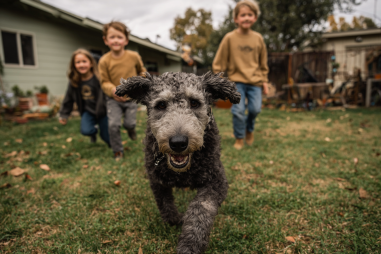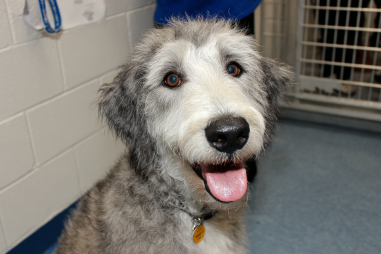Bedlington Terriers are known for their unique lamb-like appearance and affectionate nature. While they make wonderful companions, like any breed, they can develop behavioral issues if their needs aren’t properly met. Understanding the common behavioral problems in Bedlington Terriers, the causes behind them, and the best ways to address these challenges can help ensure a happy and well-adjusted dog in your home. Let’s explore what behaviors to watch out for and how to manage them effectively.
Typical Behavioral Problems in Bedlington Terriers
Bedlington Terriers are generally spirited and intelligent dogs, but they do exhibit some behavioral tendencies that owners should be aware of. Common behavioral problems reported by owners include:
- Excessive barking: Bedlingtons may bark frequently, often as a response to stimuli such as strangers, noises, or boredom.
- Separation anxiety: These dogs form strong bonds with their families and may become distressed when left alone.
- Chewing and destructive behavior: Without sufficient outlets, Bedlington Terriers can resort to chewing furniture or belongings.
- Resource guarding: Some Bedlingtons become possessive over food, toys, or even their favorite person.
- Excessive digging: This breed may dig as a form of play or to relieve stress.
- Stubbornness during training: Though intelligent, Bedlington Terriers can sometimes be independent and challenge authority if training isn’t consistent.
Causes: Boredom, Anxiety, Training Gaps
Understanding the root causes of these behaviors is key to prevention and correction. A few common triggers include:
- Boredom: Bedlington Terriers are energetic and thrive on mental and physical stimulation. Without enough activities to engage their minds and bodies, they may develop unwanted behaviors to entertain themselves.
- Anxiety: Separation anxiety is frequent in this breed due to their attachment to family members. They may feel insecure or lonely when left alone, leading to destructive behavior or incessant barking.
- Training gaps: Inconsistent or insufficient training can contribute to stubbornness and failure to follow commands. Without clear boundaries, Bedlingtons may test limits by acting out.
Signs to Watch For
Early identification of behavioral issues can prevent them from escalating. Here are signs that your Bedlington Terrier may be struggling:
- Constant or excessive barking, especially when left alone or in new environments
- Destructive chewing on furniture, shoes, or household items
- Pacing, whining, or scratching at doors as signs of separation anxiety
- Guarding food or toys aggressively around family members or visitors
- Persistent digging in the yard or inside the house
- Reluctance to obey commands or stubborn refusal to follow training
Training and Correction Techniques
Bedlington Terriers respond best to positive, consistent training methods. Here’s how you can tackle common behavioral problems:
Addressing Excessive Barking
Teach your dog the “quiet” command using reward-based training. When your Bedlington barks appropriately, praise them. If barking becomes excessive, redirect their attention to a toy or activity. Avoid yelling, as it often reinforces the barking behavior.
Combating Separation Anxiety
Gradually acclimate your dog to being alone. Start with short departures and reward calm behavior. Provide comforting items like a favorite blanket or interactive toys that can distract your pet during your absence.
Managing Destructive Chewing
Ensure your dog has plenty of chew toys and supervise closely. When you catch them chewing on inappropriate items, calmly redirect them to a toy. Consistency and patience are critical to changing this habit.
Handling Resource Guarding
Teach your Bedlington to share by exchanging treats for toys or food. Practicing trade games helps reduce guarding behavior. Avoid punishing; instead, create positive associations with people approaching their belongings.
Training Stubbornness
Keep training sessions short, engaging, and positive. Incorporate play and rewards frequently. Consistency is imperative to reinforce commands and reduce independent, stubborn behavior.
The Role of Exercise and Stimulation
Physical exercise and mental stimulation are crucial for preventing many behavioral challenges in Bedlington Terriers. Regular walks, playtime, and interactive games keep their energy channeled positively.
In addition to standard walks, consider activities that challenge their minds, such as:
- Puzzle toys that dispense treats
- Scent training or nose work games
- Agility or obedience training classes
- Interactive play with other dogs
Providing adequate daily activity helps reduce anxiety, boredom, and destructive tendencies while promoting overall well-being.
When to Seek Professional Help
If behavioral problems persist despite consistent training and exercise, it’s wise to consult a professional. A certified dog trainer or veterinary behaviorist can provide tailored strategies based on your dog’s specific needs.
Professional help is particularly important if you observe:
- Aggression that puts people or other animals at risk
- Severe separation anxiety that leads to self-harm
- Sudden onset of behavioral changes that might indicate health issues
Early intervention can prevent problems from worsening and improve the quality of life for both you and your Bedlington Terrier.
Being proactive and attentive to your Bedlington Terrier’s behavioral patterns will help you nurture a happy, balanced companion. By recognizing potential problems early and applying effective training, along with ensuring plenty of stimulation and exercise, your Bedlington can thrive as a loving, well-mannered member of your family.







